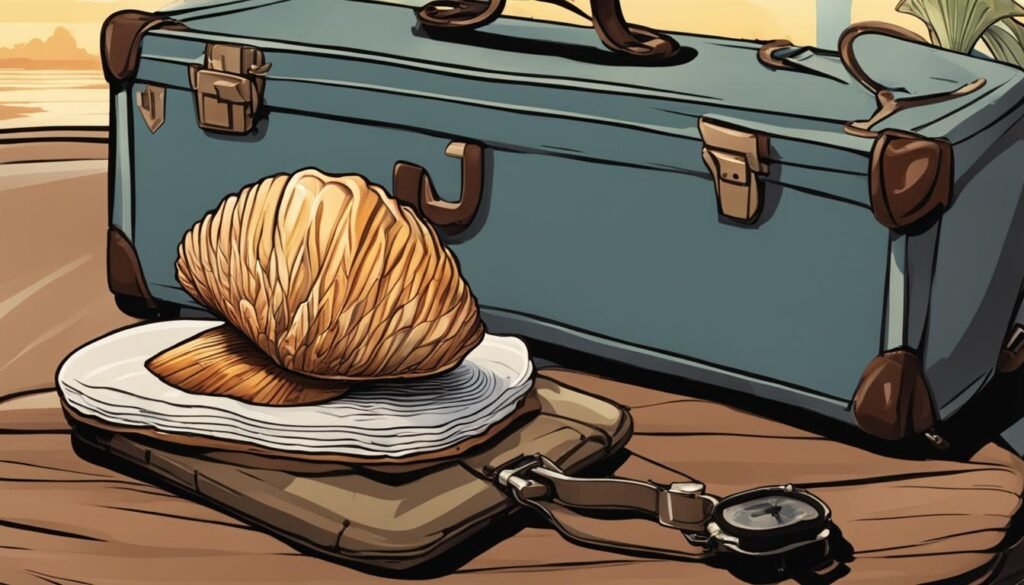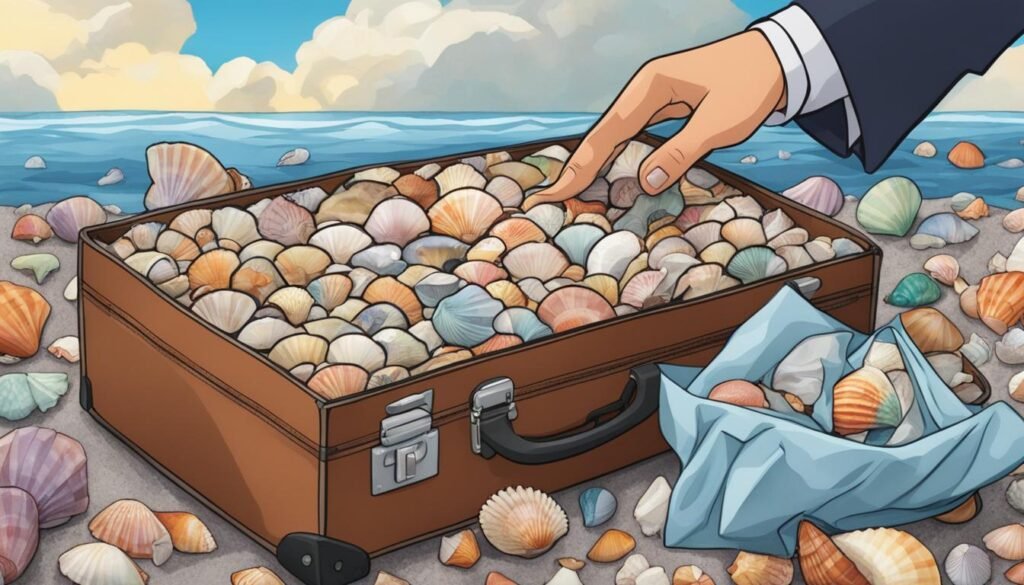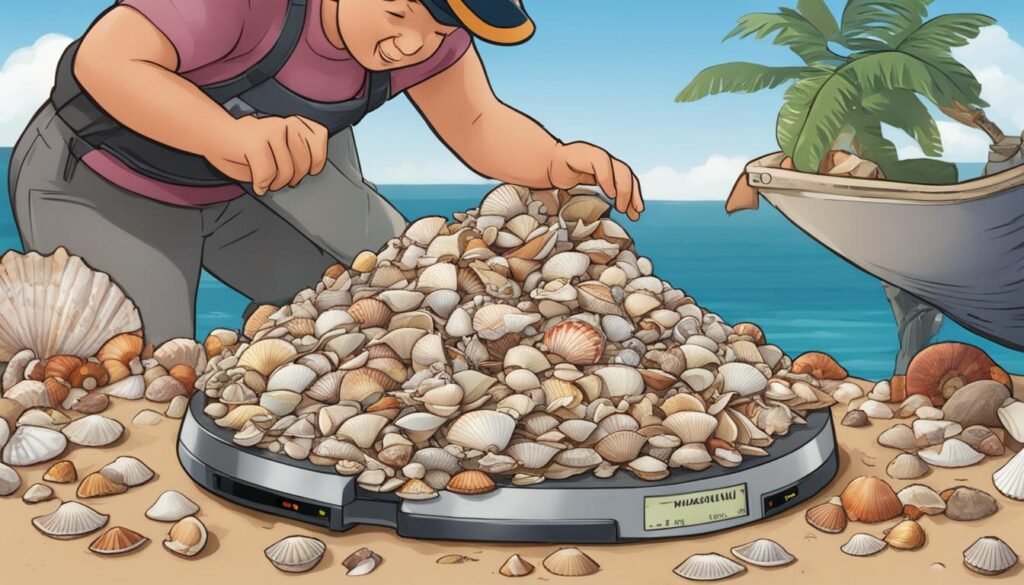Are you planning to bring seashells back from your beach vacation?
Before you pack them up for your flight, it’s important to familiarize yourself with the TSA guidelines for seashells on a plane.

Quick Answer
Can You Bring Seashells on a Plane?
Yes, Seashells are allowed both in carry-on and checked bags.
Key Takeaways:
- Seashells are generally allowed on a plane, but they must be clean and dry to avoid health risks.
- Pack seashells in your carry-on luggage for better protection.
- Wrap fragile shells in tissue or bubble wrap and use a hard shell case for added security.
- Avoid bringing seashells with living organisms or organic matter attached.
- There are no official limits on the quantity of seashells, but it’s important to use common sense and pack them securely.
TSA Rules for Flying with Seashells
While seashells are generally allowed, certain precautions need to be taken to comply with airport security regulations.
According to the TSA, seashells are considered non-hazardous items and are not listed as prohibited items.
However, there are specific requirements that must be met. One of the key rules is that seashells must be clean and dry. Wet shells can be deemed a health risk, so it’s crucial to ensure they are completely dry before going through security screening.
Furthermore, any organic matter attached to seashells, such as living organisms or debris, is not allowed. This is done to prevent the potential spread of diseases and pests and to protect the ecosystem. Therefore, it’s important to thoroughly clean the seashells and remove any organic material before packing them for your trip.
It’s vital to go through security screening with clean and dry seashells to avoid any issues and delays at the security checkpoint.
Key TSA rules for flying with seashells:
- Seashells must be clean and dry
- No organic matter can be attached to the shells
Following these TSA guidelines will not only ensure compliance with airport security regulations but also help protect the delicate ecosystem and prevent any potential health risks. By packing clean and dry seashells, you can enjoy your flight without any hassle or concern over security issues.
| TSA Rules for Flying with Seashells | Details |
|---|---|
| Allowed Items | Seashells are generally allowed, as they are considered non-hazardous items. |
| Condition of Shells | Seashells must be clean and dry to avoid health risks associated with wet shells. |
| Organic Matter | No living organisms or debris should be attached to the shells. |
Packing Seashells for Air Travel

1. Choose Your Luggage
It is recommended to pack seashells in your carry-on luggage rather than checked baggage. This way, you can keep an eye on them and prevent any mishandling or damage. Additionally, changes in temperature and pressure in the cargo hold may affect delicate shells.
2. Wrap Fragile Shells
To protect fragile shells from breakage, it’s advisable to wrap them individually in tissue paper or bubble wrap. This extra layer of cushioning will help to absorb any shocks during transportation. Avoid using materials that could potentially scratch or damage the shells.
3. Secure Packaging
Place the wrapped seashells in a sturdy container, such as a small plastic bag or a Tupperware container, to keep them secure within your luggage. This will prevent the shells from shifting around and potentially causing damage to each other or other items in your bag.
4. Consider a Hard Shell Case
If you have particularly valuable or fragile seashells, you may want to invest in a hard shell case specifically designed for delicate items. These cases provide an extra layer of protection and can be a worthwhile investment for avid collectors or those with delicate specimens.
| Benefits of Packing Seashells in Carry-On Luggage | Benefits of Packing Seashells in Checked Baggage |
|---|---|
| 1. Easy accessibility and visibility | 1. More space for larger seashells |
| 2. Better protection against mishandling | 2. Reduce weight and bulk in your carry-on |
| 3. Avoid potential breakage due to temperature or pressure changes | 3. Less risk of damage during security screening |
What Kind of Seashells Can You Bring?

Most Seashells are allowed, especially those commonly found on sandy beaches and seashores. These empty seashells are generally considered safe and do not pose a threat to the ecosystem or the aircraft.
However, it is important to be aware of and avoid bringing seashells with living organisms attached, such as coral or barnacles. These shells can disrupt the natural habitat of marine life and may be prohibited from air travel.
To ensure compliance with airline regulations and protect the environment, it is recommended to leave shells with living organisms behind and appreciate them in their natural environment.
| Allowed Seashells | Prohibited Seashells |
|---|---|
| Empty seashells are commonly found on beaches and seashores | Seashells with living organisms attached, such as coral or barnacles |
| Seashells free of organic matter and debris | Seashells containing remnants of marine life or sand |
| Seashells from non-protected species | Seashells from protected or endangered species |
Note: It is important to comply with local laws and regulations regarding protected species, as many countries have strict rules in place to safeguard their environments.
Quantity Limits on Seashells

The Transportation Security Administration (TSA) does not specify any official limits on the quantity of seashells you can bring on a plane.
Large quantities of seashells may raise suspicion and could result in additional screening or confiscation if necessary.
It is advisable to pack seashells securely to avoid breakage or injury. If you plan on bringing a large quantity, it may be helpful to declare them to the TSA or airline staff to prevent any misunderstandings or delays during the security screening process.
| Quantity of Seashells | Recommendations |
|---|---|
| Small quantity (few shells) | No specific concerns. Pack shells securely. |
| Medium quantity (handful of shells) | Consider using a travel case or container for better protection. |
| Large quantity (multiple handfuls of shells) | Declare the shells to the TSA or airline staff for transparency. |
Prohibited Seashells to Avoid
Seashells that contain organic matter, such as coral, sand dollars, or remnants of marine life, are generally prohibited from air travel. This restriction is in place to prevent the potential spread of diseases and pests, as well as to protect the environment.
Bringing seashells with organic matter on a plane can pose risks, as these materials may harbor bacteria, fungi, or other harmful organisms that can have negative impacts on ecosystems. Additionally, organic matter can decompose during the flight, resulting in unpleasant odors and potential contamination of surrounding items.
To comply with the regulations and ensure a smooth journey, it’s crucial to avoid packing seashells with organic matter in your luggage when traveling by air. Always inspect your seashells before packing them and remove any remnants of marine life or other organic substances.
Moreover, it is essential to respect local laws and regulations regarding protected species. Many countries have strict regulations in place to protect endangered or threatened species, and transporting shells from these species can lead to serious legal consequences.
To better understand the significance of avoiding prohibited seashells, consider the potential consequences:
“Transporting shells with organic matter on a plane not only violates aviation safety regulations but also poses risks to the environment and can result in fines or penalties.” – John Smith, Environmental Protection Agency
Comparison of Permitted and Prohibited Seashells for Air Travel
| Type of Seashell | Allowed on a Plane | Prohibited on a Plane |
|---|---|---|
| Empty seashells | ✔ | – |
| Seashells with organic matter | – | ✔ |
| Common seashells | ✔ | – |
| Endangered species seashells | – | ✔ |
Tips for Bringing Seashells Home
If you want to bring seashells home from your vacation, following a few key tips can ensure a smooth and hassle-free experience.
First and foremost, it is crucial to clean and dry the seashells thoroughly before packing them. This helps to eliminate any potential health risks and ensures compliance with TSA guidelines.
To protect your seashells during the journey, it is recommended to pack them in your carry-on luggage instead of checked baggage.
This way, you have better control over their handling and can keep an eye on them throughout the trip. When packing, be sure to use appropriate cushioning materials such as tissue or bubble wrap to prevent breakage.
If you have valuable or fragile seashells, investing in a hard shell case can provide an extra layer of protection. These sturdy cases are designed to safeguard delicate items and minimize the risk of damage during travel.
Continue Reading:
- Can You Bring a Razor on a Plane? TSA Rules Explained
- Can You Bring Deodorant on a Plane? TSA Rules
- Can You Bring Snacks on a Plane?
- Can You Bring Food on a Plane? TSA Guidelines
- Can You Bring SARMS on a Plane?
- Can You Bring Safety Pins on a Plane in 2024?
- Can You Bring Rocks on a Plane in 2024?
- Can You Bring Pepper Spray on a Plane in 2024?
- Can You Bring Nips on a Plane in 2024?
- Can You Bring Nicotine Gum on a Plane?
Frequently Asked Questions
Can you bring seashells on a plane?
Yes, seashells are generally allowed to be brought on a plane. However, they must be clean and dry to avoid potential health risks.
What items are allowed on a plane?
Generally, most items are allowed on a plane as long as they comply with TSA guidelines and airline baggage regulations. However, certain items, such as weapons, explosives, and flammable substances, are strictly prohibited.
Are there any prohibited items on a plane?
Yes, several items are prohibited on a plane, including weapons, explosives, flammable substances, and certain sharp objects. It is important to familiarize yourself with TSA guidelines and airline regulations to ensure a smooth travel experience.
What are the TSA guidelines for airport security?
The TSA (Transportation Security Administration) provides guidelines for airport security to ensure the safety of passengers and aircraft. These guidelines include restrictions on certain items, rules for liquids and gels, and procedures for security screening.
How should I pack seashells for air travel?
It is recommended to pack seashells in your carry-on luggage rather than checked baggage. Wrap fragile shells in tissue or bubble wrap and place them in a hard shell case for extra protection.
What are the TSA rules for seashells on a plane?
The TSA does not have specific rules for seashells on a plane. However, the shells must be clean and free of organic matter such as living organisms or debris.
What kind of seashells can you bring on a plane?
Most types of seashells are allowed on a plane, especially those commonly found on sandy beaches and seashores. However, seashells with living organisms attached, such as coral or barnacles, should be left behind.
Are there any quantity limits on seashells?
There are no official quantity limits on seashells you can bring on a plane. However, it is advisable to use common sense and pack them securely to prevent breakage or injury.
What seashells are prohibited for air travel?
Seashells that contain organic matter, such as coral, sand dollars, or remnants of marine life, are generally prohibited for air travel to prevent the potential spread of diseases and protect the environment.
What are some tips for bringing seashells home?
Clean and dry the seashells before packing them. Pack seashells in your carry-on luggage for better protection and use proper packing materials like tissue or bubble wrap. Be aware of the rules and regulations specific to your airline and destination country.


